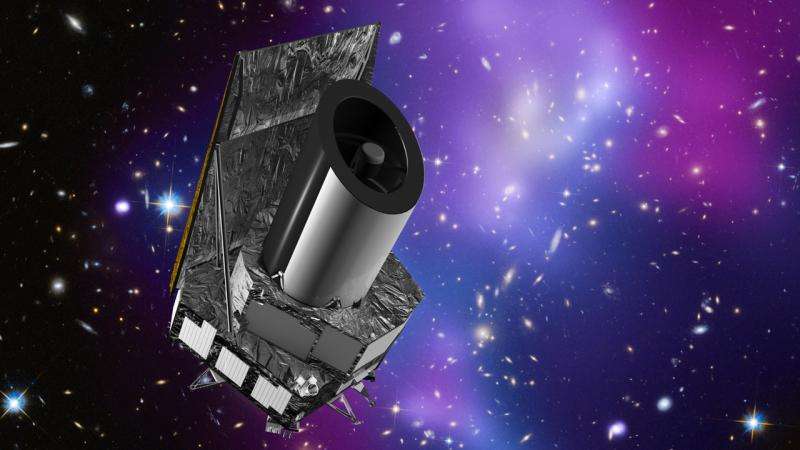October 30, 2015 report
Euclid: Observing the unseen

(Phys.org)—In a notorious hunt for elusive dark matter, seeing the unseen is the key to scientific success. The latest addition to the fleet of probes searching for dark matter, European Space Agency's (ESA) Euclid spacecraft, is being designed to bring breakthrough results while observing the yet unobserved.
"Euclid will observe the unseen, meaning the part of the universe that does not emit or absorb light, but we know it is there because of the global properties of the universe, its geometrical properties and its expansion rate," Giuseppe D. Racca, ESA's Euclid Project Manager told Phys.org.
To find the traces of dark matter, the spacecraft will map the large-scale structure of the universe over the entire extragalactic sky. According to ESA, the probe will measure galaxies out to redshifts of about two, looking back in time 10 billion years as it covers the period over which dark energy accelerated the expansion of the universe. Dark matter is invisible, but has gravity and acts to slow the expansion. It is now assumed that ordinary matter makes up only about 4 percent of the universe; the rest is actually dominated by dark matter and dark energy.
To achieve its ambitious goals, besides a 1.2 m-diameter telescope, Euclid will be equipped with two powerful instruments designed to carry out scientific observations.
"We have two instruments, one visible imager, called VIS, capable to resolve images of galaxies in the 550 to 900 nm passband. The VIS nominal survey images are used to determine the shapes of at least 30 galaxies per arcmin, for a total of 1.5 billion galaxies," Racca said.
"The other instrument is NISP [an infrared instrument], designed to carry out slitless spectroscopy and imaging photometry in the near-infrared (NIR) wavelength. The NISP spectroscopy measures the redshifted H-alpha emission line of galaxies," he added.
VIS and NISP, large-format cameras, will be used to characterize the morphometric, photometric and spectroscopic properties of galaxies. Euclid will use two techniques to observe the invisible, called galaxy clustering (GC) and weak lensing (WL).
In Euclid's case, GC means performing a measurement of the redshift distribution of galaxies from their H-alpha emission line survey using near-infrared slitless spectroscopy. This method also provides direct information of the validity of general relativity because it enables monitoring the evolution of structures subject to the combined effects of gravity, which forces clumping of matter and the opposing force caused by the accelerated expansion.
The WL technique measures the distortion of the galaxy shapes due to the gravitational lensing caused by the predominantly dark matter distribution from the galaxies and the observer. The obtained galaxy shear field can be transformed into the matter distribution. WL requires extremely high image quality because possible image distortions by the optical system must be suppressed or calibrated out in order to measure the true distortions caused by gravity.
"It is important that the two techniques are performed at the same time. The complementarity of the two probes will, indeed, provide important additional information on possible systematics, which limit the accuracy of each of the probes," Racca noted.
The Euclid mission is currently on track for the planned launch in late 2020. It was selected for implementation as a Medium-class mission in ESA's Cosmic Vision program in October 2011 and formally adopted in June 2012. The mission will operate from the Sun–Earth Lagrangian point (L2), situated 1.5 million km from Earth. Science and spacecraft operations will be conducted by ESA. The Euclid Consortium, consisting of more than one hundred scientific institutes, is responsible for the development and delivery of the spacecraft's instruments and the scientific data processing.
© 2015 Phys.org





















